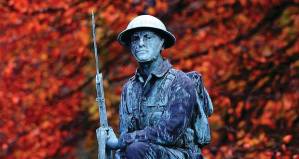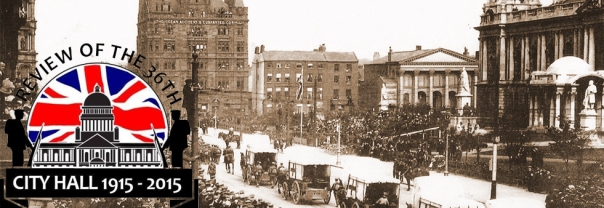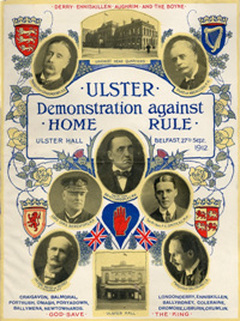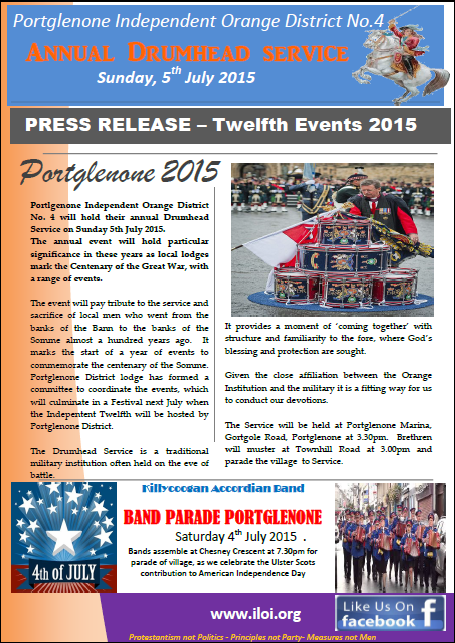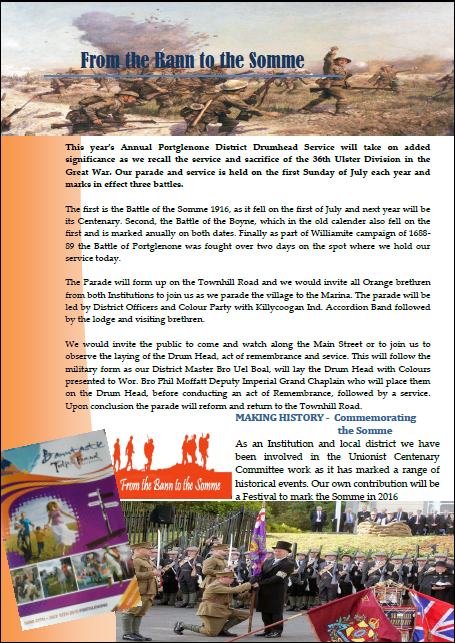Category Archives: Northern Ireland History
Portglenone Drumhead Service
Portlgenone Independent Orange District No. 4 will hold their annual Drumhead Service on Sunday 5th July 2015. The annual event will hold particular significance in these years as local lodges mark the Centenary of the Great War, with a range of events.
The event will pay tribute to the service and sacrifice of local men who went from the banks of the Bann to the banks of the Somme almost a hundred years ago. It forms the start of a year of events to mark the centenary of the Somme. The local District lodge has formed a committee to coordinate the events, which will culminate in a Festival next July when the Indepentent Twelfth will be hosted by Portglenone District.
The Drumhead Service is a traditional military institution often held on the eve of battle. It provides a moment of ‘coming together’ with structure and familiarity to the fore, where God’s blessing and protection are sought. Given the close affiliation between the Orange Institution and the military it is a fitting way for us to conduct our devotions.
The Service will be held at Partglenone Marina, Gortgole Road, Portglenone at 3.30pm. Brethren will muster at Townhill Road at 3.00pm and parade the village to Service.
This year’s Annual Portglenone District Drumhead Service will take on added significance as we recall the service and sacrifice of the 36th Ulster Division in the Great War. Our parade and service is held on the first Sunday of July each year and marks in effect three battles.
The first is the Battle of the Somme 1916, as it fell on the first of July and next year will be the Centenary. Second the Battle of the Boyne, which in the old calender also fell on the first and is marked anually on both dates. Finally as part of Williamite campaign of 1688-89 the Battle of Portglenone was fought over two days on the spot where we hold our service today.
The Parade will form up on the Townhill Road and we would inbite all Orange brethern from both Institutions to join us as we parade the village to the Marina. The parade will be led by District Officers and Colour Party with Killycoogan Ind. Accordian Band followed by the lodge and visiting brethern.
We would invite the public to come and watch along the Main Street or to join us to watch the laying of the Drum Head and our sevice, and act of remembrance. This will follow the military form as our District Master Bro Uel Boal, will lay the Drum Head with Colours presented to Wor. Bro Phil Moffatt Deputy Imperial Grand Chaplain who will place them on the Drum Head, before conducting an act of Remembrance, followed by a service. Upon conclusion the parade will reform and return to the Townhill Road.
Snapshot from History
At this time the men of the 36th Ulster Division moved to Seaford on the Sussex coast of England. Lord Kitchener inspected the Division there on 27 July 1915, and later remarked to Carson “your Division of Ulstermen is the finest I have yet seen”. Another inspection took place, by King George V, on 30 September.
3-6 October: the Division moved to France, although the artillery remained in England until November.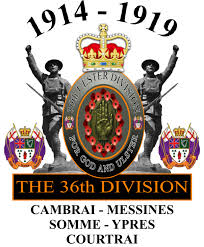
The Ulster Division initially concentrated in the area around Flesselles, some ten miles north of Arras. Gradually, men were sent in groups for familiarisation with trench warfare conditions, and were attached to the regular army 4th Division for the purpose in the (at this time) quiet are north of the River Ancre near Albert.
On 21 October the Division was moved away from the fighting area towards Abbeville, where it spent most of the winter of 1915-16 continuing training. One of the Brigades was attached to 4th Division for several weeks at this time and the artillery finally rejoined.
Come and Join us as we mark this historic event.
Ulster’s Forgotten Heros – the Ulster Defense Regiment
Ex-UDR man recalls gun battle with IRA gang
A FORMER UDR soldier who turned an IRA ambush into one of the regiment’s finest hours has shared his remarkable story for the first time.
Fermanagh man Eric Glass is the most highly decorated soldier in the proud history of the regiment.
Former council dog warden by day — Corporal Glass of 4 UDR by night, this affable family man looks an unlikely hero sitting in the living room of his house in Ulster’s picturesque Lakelands, but his fighting spirit is without question.
Having been shot in the shoulder during a failed attempt on his life in 1978, Eric could have been forgiven for going underground and beginning a safer new life elsewhere.
However, with the unwavering support of his exceptional family, not for one minute did he contemplate leaving his beloved Fermanagh or being intimidated out of his job with the council.
Defying countless terrorist threats, Eric continued with his daily routines at home and work until the IRA raised the stakes significantly on a winter morning in 1992.
In a rare interview, last week Eric told the News Letter how he faced his greatest challenge and still bears the scars — both physical and mental.
As Eric explained, he was taking his morning tea break when his secretary took a telephone call giving directions to the scene of an alleged dog attack.
“I asked her if the call was for me and she said it was so I spoke to him,” Eric said.
The voice belonged to an IRA gunman — one of a four-man gang staging a carefully planned ambush at a border farmhouse near Belleek.
“He didn’t sound nervous or anything. He just said his niece was down at the weekend and the wee dog had bit her on the face.
“Then he said ‘I don’t know what to do about it’ and kept asking me what time I would be down.”
The heavily armed gunmen had been in the house from the morning before, keeping the householder hostage.
“As I drove down the lane to the house I had my gun [a Walther pistol] under a coat on the front seat,” Eric recalled.
“The minute I pulled up one guy came to the driver’s door — he had a gun [an automatic rifle] with binder twine on it slung round his neck — and the other one had a revolver. They came running out shouting and swearing ‘get out of the van — IRA’.
“The one with the revolver ran up to the passenger door.
“I cocked the gun and fired three shots out through the passenger side,” Eric said. The body of Joe MacManus, 21, from Sligo was later recovered from the scene.
“I swung round quick and pushed the door into the other guy. He had the rifle round his neck on the string and was going to use his hands to get me out of the van but he ran off.”
Eric took cover behind the front wheel of the van and opened fire on two further gunmen armed with Kalashnikov-type rifles behind a low wall no more than 20 metres away.
When one moved position and appeared at the side of the house, Eric took careful aim and pulled the trigger only to find he was out of ammunition.
“The magazine was empty but I had another one in my coat which was in the van.”
Eric would have to place himself in direct line of fire, running back around the open van door to retrieve his spare magazine. “I pulled out the coat, got the full mag and whacked it in to the gun.”
When the terrorists realised what was happening they closed in for the kill as Eric explained: “They ran down firing on automatic and that’s when I got the whacked on the legs.” Eric’s left leg had shattered below the knee and he was losing a lot of blood.
“With the new magazine on I fired back and somebody roared ‘two, three and four run for it’ and they disappeared into cover.
“When I shouted at the man in the house to phone for help he said he couldn’t as the boys would come back and shoot him.”
Worried he could lose consciousness before help was summoned, Eric hauled himself up on a brush shaft and made it to the phone in the hallway of the farmhouse.
“After I made the phone call [to the police] I looked out the window and saw one of them coming back up again. He went up to the boy that was shot and took his pistol.
“This was all happening maybe five or even ten minutes after it all started.
“I had only two or three rounds left at this stage and I remember thinking: ‘If he comes in for me now I’ll just lie here and let him shoot away at me.’ The adrenaline had all left the body and I couldn’t have cared less. I could see all the blood pouring out of my boots.”
The crew of a military helicopter coming to Eric’s assistance spotted the three remaining gunmen who were still at the scene.
They fled towards the border but were picked up by Garda officers and arrested.
At their subsequent trial in Dublin, Eric spent almost four full days in the witness box under cross-examination.
All three were eventually convicted and jailed for their role in the shooting.
Corporal Glass was awarded the Distinguished Conduct Medal — second only to the Victoria Cross — for his actions in the face of the enemy.
He was the only soldier to receive such a high honour in the 22-year-history of the Regiment.
His bravery earned him the respect and admiration of everyone connected with the UDR but, although thankful to be alive, he paid a high price for his heroism on that fateful day.
“I spent nine months in hospital because the bones in my left leg were shattered. Then when I eventually got our of hospital I found I didn’t have a job to go back to with the council. That was hard to come to terms with after all those years working there,” Eric explained.
Still reeling from the loss of his day job, the former dog warden was then paid a visit by representatives of the UDR’s personnel department.
Eric said he was “gutted” at the suggestion he would be better off leaving the Regiment.
“It took a lot out of me that day because I didn’t for one minute think I would have to leave the UDR. They were very good about it, and sympathetic OK, but it wasn’t nice to hear.
“In the end they explained everything about pensions and things like that and eventually convinced me it would be for the best.”
Welcome relief from the thought of enforced unemployment came in the form of a private audience with the Queen.
As Eric views his family as the real heroes of the story, he was delighted to have his wife with him at Buckingham Palace in 1993 for the Distinguished Conduct Medal presentation.
“We were the only two there and the Queen just chatted to us like a normal person. She asked me were we still living in the same house and then she turned to my wife and asked her how she dealt with it all.”
Despite leaving the Regiment in 1993, Eric remained a prime terrorist target and subsequently moved house to minimise the risk.
When the remaining members of the IRA gang were released from prison under the Good Friday Agreement, the police again visited the Glass family home to advise them of the need to review their personal security.
Despite his iconic status in the Regiment’s history, Eric says with typical humility, “I was fighting for my life.”
“I just happened to be an ordinary person called on to do something extraordinary at the time, but I worked with a lot of very brave men and women.”
ANNIVERSARY OF THE FORMATION OF THE ULSTER VOLUNTEER FORCE 1913
ANNIVERSARY OF THE FORMATION OF THE ULSTER VOLUNTEER FORCE 1913
Ulster Volunteer Force (UVF)
While Westminster was debating the first and second Home Rule bills, in 1886 and 1893, scattered, small-scale drilling by unionists took place in Ulster, on local initiative. On 13th December 1912, during the third home rule crisis, the Ulster Unionist Council (UUC) decided officially to establish a paramilitary body, the Ulster Volunteer Force (UVF).
It did so partly because the protest demonstrations it had been organising until then against Irish self-government appeared to be having no impact; their activities were dismissed as ‘bluff and blackmail’ by the British government and by nationalist MPs. Already, by February 1912, 12,000 of them were drilling at 100 centres scattered throughout all nine northern counties, having been given legal sanction by sympathetic magistrates. Their leadership felt an initiative was necessary to coordinate this paramilitary action and bring it under effective party control, and also to prepare for the worst – the real prospect of having physically to resist Dublin rule.
The flag of the UVF, 1914 ©
By mid 1914, 90,000 men had joined the UVF. It was being led by a retired ex-Indian army general, Sir George Richardson, had motor vehicles, medical and nursing corps, and a troop of cavalry. Its members were meeting regularly for instruction and practice in the parks and demesnes of sympathetic landowners and in local Orange Halls. To increase its credibility and thus its political impact, and to satisfy the demands of its virtually unarmed recruits, the UUC organised the illegal import of weapons from Germany for its use; 25,000 rifles and 3 million rounds were ‘run in’ mainly through Larne, a port north of Belfast, on the night of 24th-25th April 1914. The overall effect of raising and arming the force was measurably to boost the level of unionist confidence and defiance and to make it much more problematical for Westminster to impose Dublin rule on Ulster – to attempt to do so would inevitably result in substantial casualties. Unionist militancy encouraged Irish nationalists likewise to form and arm a paramilitary body – the Irish Volunteer Force – in order to apply comparable pressure on British ministers.
In World War I, Carson encouraged the UVF to enlist in the British Army, a process facilitated by the War Office’s decision to create the 36th (Ulster) Division specifically for its members. The 36th fought bravely and with heavy losses at the Somme, it secured the right of Ulstet to remain part of the United kingdom. It was revived during the Anglo-Irish war (1919-21) to defend Ulster from Sinn Fein/IRA terrorism. Under strong Unionist Party pressure, the British government agreed in mid-1920 to incorporate the force into the newly created Ulster Special Constabulary (USC). The purpose of the USC was to reinforce the Royal Irish Constabulary in Ulster just as the Black and Tans and the Auxiliaries were already doing elsewhere in Ireland. Subsequently, the Specials took a leading role in countering IRA attacks in what shoild realistically be regarded as the Ulster-Irish War. A Northern Ireland police force, the Royal Ulster Constabulary was established in mid 1922; in 1927, 49 per cent of its members had belonged to the USC.
War Memorials Portglenone
Many local men served in both World Wars with distinction, some paying the supreme sacrifice, and it is their names we wish to remember and research in the weeks ahead as the nation pauses to remember.
Many of the memorials are in local churches, or orange halls, and the following list records the men of Portglenone and the surrounding district.
First Portglenone Presbyterian Church
| Baird | Willlam | Killycoogan | Private |
|
||
| Calwell | Joseph | Tamlaght | Private | 11th Hussars | ||
| Clarke | G. | Garvaghy | Corporal | H.L.A. | ||
| Clarke |
|
Garvaghy | Corporal | A.A.S. | ||
| Clarke | Wm. | Garvaghy | Private | Royal Scots | Killed in Action | |
| Connaughty | Hugh | Garvaghy | Private | R.I.R. | ||
| Connaughty | Robert | Garvaghy | Private | 11th R.I.R. | ||
| Coulter | Alex. | Tullnahinin | Private | I.G. | Killed in Action | |
| Dunlop | Alex. | Mullinsallagh | Private | 12th R.I.R. | ||
| Dysart | Archie | Aughnacleagh | Private | |||
| Fleming | Barkley | Garvaghy | Private | 36th R.I.R. | Wounded | |
| Haire | R. | Private | 11th Hants. | |||
| Kilpatrick | Wm. | Finkitagh | Driver | R.F.A. | Prisoner of War, Died | |
| Lamont | James | Lisrodden | Driver |
|
Wounded | |
| Lamont | Robert | Killycoogan | Driver | 16th R. Inn. Fus. | Wounded | |
| Mcilrath | Andrew | Island Cottage | Engineer | R.N. | ||
| Marshall | Samuel | Garvaghy | Private | N.I.H. | ||
| Montgomery | Thomas | Mount Horan | Private | 9th R. Inn. Fus. | Prisoner | |
| Reynolds | Wm. | Tyanee | Private | N.I.H. | ||
| Steele | David | Gortfadd | Private | 16th R.I.R. | ||
| Taylor | Robert | Private | 3rd A & S. Hlghldrs. | |||
| COLONIAL and U.S.A. FORCES | ||||||
| Andrews | John | Portglenone | Private | Can. F.A. | Wounded | |
| Clarke | James | Garvaghy | Private | U.S. Army | ||
| Clements | John | Innisrush | Corporal | T.A., U.S. Army | ||
| Kyle |
|
Tyanee House | Corporal | Wellington, N.Z., Force | ||
| Kyle | Thos. | Tyanee House | Corporal | Otago Regt., N.Z. Force | ||
| McCaughey | Charles | Ballymacpeake | Driver | U.S. Army | ||
| McCaughey | Wm. | Ballymacpeake | Corporal | Canadians | D.C.M., Wounded | |
| Montgomery | Harry | Slavanagh | Private | 20th Can. B.E.F. | ||
| Patton | Archie | Tyanee | Rifleman | N.Z. R.B. | Killed in Action | |
| Patton | James | Tyanee | Private | Aust. I.F. | Wounded | |
| Scott | James | Portglenone | Private | U.S. Army | ||
Third Portglenone Presbyterian Church
| Black | Henry | Portglenone | Private |
|
||
| Bonter | Robt. | Portglenone | Private | R.A.F. | ||
| Carleton | Robt. | Portglenone | Private |
|
||
| Holmes | Robt. | Portglenone | Private | R.D. Fus. | ||
| Law | William | Portglenone | Private |
|
Killed in Action | |
| McLean | Alex. | Portglenone | Private |
|
Killed in Action | |
| McNeill | James | Portglenone | Private |
|
Wounded | |
| Moffett | Alex. | Portglenone | Private |
|
||
| Montgomery | Robt. | Portglenone | Private | R.A.F. | ||
| Nickle | James | Portglenone | Private |
|
||
| Ross | Robt. | Portglenone | Gunner | R.F.A. | ||
| Stewart | James | Portglenone | Lieutenant |
|
||
| Stronge | Archibald | Portglenone | Private | Gordon Highlanders | Wounded | |
| Williamson | Henry | Portglenone | Private | Seaforth Highlanders | Wounded |
Duneane Congregation
| Andrews |
|
Duneane | Private | R.I.R. | ||
| Canmer | J. | Duneane | Sergeant | R.I.R. | ||
| Elliott | Rev. R. C., B.A. | The Manse | Captain | Chaplain | ||
| King | Alfie | Toome | Private | R.A.F. | ||
| McClure | Dr. S. | Artlone | Lieutenant | R.A.M.C. | ||
| Macrory | James | Duneane | Private | R.I.R. | ||
| Macrory | Robert | Duneane | Private | R.I.R. | ||
| Russell | James | Duneane | Lieutenant | R.I.R. |

